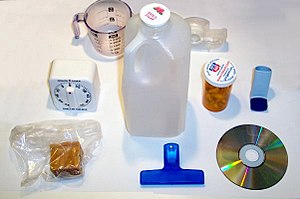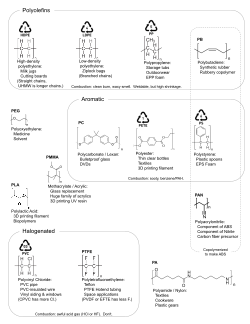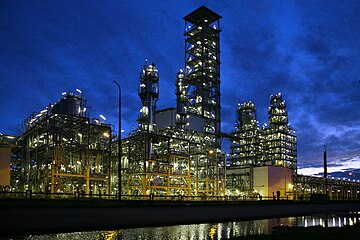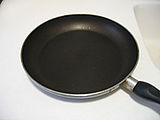
A | B | C | D | E | F | G | H | CH | I | J | K | L | M | N | O | P | Q | R | S | T | U | V | W | X | Y | Z | 0 | 1 | 2 | 3 | 4 | 5 | 6 | 7 | 8 | 9

Plastics are a wide range of synthetic or semi-synthetic materials that use polymers as a main ingredient. Their plasticity makes it possible for plastics to be molded, extruded or pressed into solid objects of various shapes. This adaptability, plus a wide range of other properties, such as being lightweight, durable, flexible, and inexpensive to produce, has led to their widespread use. Plastics typically are made through human industrial systems. Most modern plastics are derived from fossil fuel-based chemicals like natural gas or petroleum; however, recent industrial methods use variants made from renewable materials, such as corn or cotton derivatives.[1]
9.2 billion metric tons of plastic are estimated to have been made between 1950 and 2017, more than half of which has been produced since 2004. In 2020, 400 million tons of plastic were produced.[2] If global trends on plastic demand continue, it is estimated that by 2050 annual global plastic production will reach over 1.1 billion tons.
The success and dominance of plastics starting in the early 20th century has caused widespread environmental problems,[3] due to their slow decomposition rate in natural ecosystems. Most plastic produced has not been reused, or is incapable of reuse, either being captured in landfills or persisting in the environment as plastic pollution and microplastics. Plastic pollution can be found in all the world's major water bodies, for example, creating garbage patches in all of the world's oceans and contaminating terrestrial ecosystems. Of all the plastic discarded so far, some 14% has been incinerated and less than 10% has been recycled.[2]
In developed economies, about a third of plastic is used in packaging and roughly the same in buildings in applications such as piping, plumbing or vinyl siding.[4] Other uses include automobiles (up to 20% plastic[4]), furniture, and toys.[4] In the developing world, the applications of plastic may differ; 42% of India's consumption is used in packaging.[4] In the medical field, polymer implants and other medical devices are derived at least partially from plastic. Worldwide, about 50 kg of plastic is produced annually per person, with production doubling every ten years.
The world's first fully synthetic plastic was Bakelite, invented in New York in 1907, by Leo Baekeland,[5] who coined the term "plastics".[6] Dozens of different types of plastics are produced today, such as polyethylene, which is widely used in product packaging, and polyvinyl chloride (PVC), used in construction and pipes because of its strength and durability. Many chemists have contributed to the materials science of plastics, including Nobel laureate Hermann Staudinger, who has been called "the father of polymer chemistry," and Herman Mark, known as "the father of polymer physics".[7]
Etymology
The word plastic derives from the Greek πλαστικός (plastikos) meaning "capable of being shaped or molded," and in turn from πλαστός (plastos) meaning "molded."[8] As a noun the word most commonly refers to the solid products of petrochemical-derived manufacturing.[9]
The noun plasticity refers specifically here to the deformability of the materials used in the manufacture of plastics. Plasticity allows molding, extrusion or compression into a variety of shapes: films, fibers, plates, tubes, bottles and boxes, among many others. Plasticity also has a technical definition in materials science outside the scope of this article referring to the non-reversible change in form of solid substances.
Structure
Most plastics contain organic polymers.[10] The vast majority of these polymers are formed from chains of carbon atoms, with or without the attachment of oxygen, nitrogen or sulfur atoms. These chains comprise many repeating units formed from monomers. Each polymer chain consists of several thousand repeating units. The backbone is the part of the chain that is on the main path, linking together a large number of repeat units. To customize the properties of a plastic, different molecular groups called side chains hang from this backbone; they are usually hung from the monomers before the monomers themselves are linked together to form the polymer chain. The structure of these side chains influences the properties of the polymer.
Properties and classifications
Plastics are usually classified by the chemical structure of the polymer's backbone and side chains. Important groups classified in this way include the acrylics, polyesters, silicones, polyurethanes, and halogenated plastics. Plastics can be classified by the chemical process used in their synthesis, such as condensation, polyaddition, and cross-linking.[11] They can also be classified by their physical properties, including hardness, density, tensile strength, thermal resistance, and glass transition temperature. Plastics can additionally be classified by their resistance and reactions to various substances and processes, such as exposure to organic solvents, oxidation, and ionizing radiation.[12] Other classifications of plastics are based on qualities relevant to manufacturing or product design for a particular purpose. Examples include thermoplastics, thermosets, conductive polymers, biodegradable plastics, engineering plastics and elastomers.
Thermoplastics and thermosetting polymers

One important classification of plastics is the degree to which the chemical processes used to make them are reversible or not.
Thermoplastics do not undergo chemical change in their composition when heated and thus can be molded repeatedly. Examples include polyethylene (PE), polypropylene (PP), polystyrene (PS), and polyvinyl chloride (PVC).[13]
Thermosets, or thermosetting polymers, can melt and take shape only once: after they have solidified, they stay solid.[14] If reheated, thermosets decompose rather than melt. In the thermosetting process, an irreversible chemical reaction occurs. The vulcanization of rubber is an example of this process. Before heating in the presence of sulfur, natural rubber (polyisoprene) is a sticky, slightly runny material; after vulcanization, the product is dry and rigid.
Amorphous plastics and crystalline plastics
Many plastics are completely amorphous (without a highly ordered molecular structure),[15] including thermosets, polystyrene, and methyl methacrylate (PMMA). Crystalline plastics exhibit a pattern of more regularly spaced atoms, such as high-density polyethylene (HDPE), polybutylene terephthalate (PBT), and polyether ether ketone (PEEK). However, some plastics are partially amorphous and partially crystalline in molecular structure, giving them both a melting point and one or more glass transitions (the temperature above which the extent of localized molecular flexibility is substantially increased). These so-called semi-crystalline plastics include polyethylene, polypropylene, polyvinyl chloride, polyamides (nylons), polyesters and some polyurethanes.
Conductive polymers
Intrinsically Conducting Polymers (ICP) are organic polymers that conduct electricity. While a conductivity of up to 80 kS/cm in stretch-oriented polyacetylene,[16] has been achieved, it does not approach that of most metals. For example, copper has a conductivity of several hundred kS/cm.[17]
Biodegradable plastics and bioplastics
Biodegradable plastics
Biodegradable plastics are plastics that degrade (break down) upon exposure to sunlight or ultra-violet radiation; water or dampness; bacteria; enzymes; or wind abrasion. Attack by insects, such as waxworms and mealworms, can also be considered as forms of biodegradation. Aerobic degradation requires that the plastic be exposed at the surface, whereas anaerobic degradation would be effective in landfill or composting systems. Some companies produce biodegradable additives to enhance biodegradation. Although starch powder can be added as a filler to allow some plastics to degrade more easily, such treatment does not lead to complete breakdown. Some researchers have genetically engineered bacteria to synthesize completely biodegradable plastics, such as polyhydroxy butyrate (PHB); however, these were still relatively costly as of 2021.[18]
Bioplastics
While most plastics are produced from petrochemicals, bioplastics are made substantially from renewable plant materials like cellulose and starch.[19] Due both to the finite limits of fossil fuel reserves and to rising levels of greenhouse gases caused primarily by the burning of those fuels, the development of bioplastics is a growing field.[20][21] Global production capacity for bio-based plastics is estimated at 327,000 tonnes per year. In contrast, global production of polyethylene (PE) and polypropylene (PP), the world's leading petrochemical-derived polyolefins, was estimated at over 150 million tonnes in 2015.[22]
Plastic industry
The plastic industry includes the global production, compounding, conversion and sale of plastic products. Although the Middle East and Russia produce most of the required petrochemical raw materials, the production of plastic is concentrated in the global East and West. The plastic industry comprises a huge number of companies and can be divided into several sectors:
Production
Between 1950 and 2017, 9.2 billion tonnes of plastic are estimated to have been made, with more than half this having been produced since 2004. Since the birth of the plastic industry in the 1950s, global production has increased enormously, reaching 400 million tonnes a year in 2021; this is up from 381 million metric tonnes in 2015 (excluding additives).[2][23] From the 1950s, rapid growth occurred in the use of plastics for packaging, in building and construction, and in other sectors.[2] If global trends on plastic demand continue, it is estimated that by 2050 annual global plastic production will exceed 1.1 billion tonnes annually.[2]
- Polypropylene plants
-
A SOCAR Polymer polypropylene plant in Sumgayit, Azerbaijan
Graphs are unavailable due to technical issues. There is more info on Phabricator and on MediaWiki.org. |
Plastics are produced in chemical plants by the polymerization of their starting materials (monomers); which are almost always petrochemical in nature. Such facilities are normally large and are visually similar to oil refineries, with sprawling pipework running throughout. The large size of these plants allows them to exploit economies of scale. Despite this, plastic production is not particularly monopolized, with about 100 companies accounting for 90% of global production.[24] This includes a mixture of private and state-owned enterprises. Roughly half of all production takes place in East Asia, with China being the largest single producer. Major international producers include:
| Region | Global production |
|---|---|
| China | 31% |
| Japan | 3% |
| Rest of Asia | 17% |
| NAFTA | 19% |
| Latin America | 4% |
| Europe | 16% |
| CIS | 3% |
| Middle East & Africa | 7% |
- Dow Chemical
- LyondellBasell
- Exxonmobil
- SABIC
- BASF
- Sibur
- Shin-Etsu Chemical
- Indorama Ventures
- Sinopec
- Braskem
Historically, Europe and North America have dominated global plastics production. However, since 2010 Asia has emerged as a significant producer, with China accounting for 31% of total plastic resin production in 2020.[25] Regional differences in the volume of plastics production are driven by user demand, the price of fossil fuel feedstocks, and investments made in the petrochemical industry. For example, since 2010 over US$200 billion has been invested in the United States in new plastic and chemical plants, stimulated by the low cost of raw materials. In the European Union (EU), too, heavy investments have been made in the plastics industry, which employs over 1.6 million people with a turnover of more than 360 billion euros per year. In China in 2016 there were over 15,000 plastic manufacturing companies, generating more than US$366 billion in revenue.[2]
In 2017, the global plastics market was dominated by thermoplastics– polymers that can be melted and recast. Thermoplastics include polyethylene (PE), polyethylene terephthalate (PET), polypropylene (PP), polyvinyl chloride (PVC), polystyrene (PS) and synthetic fibers, which together represent 86% of all plastics.[2]
Compounding

Plastic is not sold as a pure unadulterated substance, but is instead mixed with various chemicals and other materials, which are collectively known as additives. These are added during the compounding stage and include substances such as stabilizers, plasticizers and dyes, which are intended to improve the lifespan, workability or appearance of the final item. In some cases, this can involve mixing different types of plastic together to form a polymer blend, such as high impact polystyrene. Large companies may do their own compounding prior to production, but some producers have it done by a third party. Companies that specialize in this work are known as Compounders.
The compounding of thermosetting plastic is relatively straightforward; as it remains liquid until it is cured into its final form. For thermosoftening materials, which are used to make the majority of products, it is necessary to melt the plastic in order to mix-in the additives. This involves heating it to anywhere between 150–320 °C (300–610 °F). Molten plastic is viscous and exhibits laminar flow, leading to poor mixing. Compounding is therefore done using extrusion equipment, which is able to supply the necessary heat and mixing to give a properly dispersed product.
The concentrations of most additives are usually quite low, however high levels can be added to create Masterbatch products. The additives in these are concentrated but still properly dispersed in the host resin. Masterbatch granules can be mixed with cheaper bulk polymer and will release their additives during processing to give a homogeneous final product. This can be cheaper than working with a fully compounded material and is particularly common for the introduction of color.
Converting
Companies that produce finished goods are known as converters (sometimes processors). The vast majority of plastics produced worldwide are thermosoftening and must be heated until molten in order to be molded. Various sorts of extrusion equipment exist which can then form the plastic into almost any shape.
- Film blowing - Plastic films (carrier bags, sheeting)
- Blow molding - Small thin-walled hollow objects in large quantities (drinks bottles, toys)
- Rotational molding - Large thick-walled hollow objects (IBC tanks)
- Injection molding - Solid objects (phone cases, keyboards)
- Spinning - Produces fibers (nylon, spandex etc.)
For thermosetting materials the process is slightly different, as the plastics are liquid to begin with and but must be cured to give solid products, but much of the equipment is broadly similar.
The most commonly produced plastic consumer products include packaging made from LDPE (e.g. bags, containers, food packaging film), containers made from HDPE (e.g. milk bottles, shampoo bottles, ice cream tubs), and PET (e.g. bottles for water and other drinks). Together these products account for around 36% of plastics use in the world. Most of them (e.g. disposable cups, plates, cutlery, takeaway containers, carrier bags) are used for only a short period, many for less than a day. The use of plastics in building and construction, textiles, transportation and electrical equipment also accounts for a substantial share of the plastics market. Plastic items used for such purposes generally have longer life spans. They may be in use for periods ranging from around five years (e.g. textiles and electrical equipment) to more than 20 years (e.g. construction materials, industrial machinery).[2]
Plastic consumption differs among countries and communities, with some form of plastic having made its way into most people's lives. North America (i.e. the North American Free Trade Agreement or NAFTA region) accounts for 21% of global plastic consumption, closely followed by China (20%) and Western Europe (18%). In North America and Europe there is high per capita plastic consumption (94 kg and 85 kg/capita/year, respectively). In China there is lower per capita consumption (58 kg/capita/year), but high consumption nationally because of its large population.[2]
Types of plastics
Commodity plastics

Around 70% of global production is concentrated in six major polymer types, the so-called commodity plastics. Unlike most other plastics these can often be identified by their resin identification code (RIC):
 Polyethylene terephthalate (PET or PETE)
Polyethylene terephthalate (PET or PETE) High-density polyethylene (HDPE or PE-HD)
High-density polyethylene (HDPE or PE-HD) Polyvinyl chloride (PVC or V)
Polyvinyl chloride (PVC or V) Low-density polyethylene (LDPE or PE-LD),
Low-density polyethylene (LDPE or PE-LD), Polypropylene (PP)
Polypropylene (PP) Polystyrene (PS)
Polystyrene (PS)
Polyurethanes (PUR) and PP&A fibers[26] are often also included as major commodity classes, although they usually lack RICs, as they are chemically quite diverse groups. These materials are inexpensive, versatile and easy to work with, making them the preferred choice for the mass production everyday objects. Their biggest single application is in packaging, with some 146 million tonnes being used this way in 2015, equivalent to 36% of global production. Due to their dominance; many of the properties and problems commonly associated with plastics, such as pollution stemming from their poor biodegradability, are ultimately attributable to commodity plastics.
A huge number of plastics exist beyond the commodity plastics, with many having exceptional properties.
Graphs are unavailable due to technical issues. There is more info on Phabricator and on MediaWiki.org. |
| Polymer | Production (Mt) | Percentage of all plastics (%) | Polymer type | Thermal character |
|---|---|---|---|---|
| Low-density polyethylene (LDPE) | 64 |
15.7 |
Polyolefin | Thermoplastic |
| High-density polyethylene (HDPE) | 52 |
12.8 |
Polyolefin | Thermoplastic |
| polypropylene (PP) | 68 |
16.7 |
Polyolefin | Thermoplastic |
| Polystyrene (PS) | 25 |
6.1 |
Unsaturated polyolefin | Thermoplastic |
| Polyvinyl chloride (PVC) | 38 |
9.3 |
Halogenated | Thermoplastic |
| Polyethylene terephthalate (PET) | 33 |
8.1 |
Condensation | Thermoplastic |
| Polyurethane (PUR) | 27 |
6.6 |
Condensation | Thermoset[27] |
| PP&A Fibers[26] | 59 |
14.5 |
Condensation | Thermoplastic |
| All Others | 16 |
3.9 |
Various | Varies |
| Additives | 25 |
6.1 |
- | - |
| Total | 407 |
100 |
- | - |
Engineering plastics
Engineering plastics are more robust and are used to make products such as vehicle parts, building and construction materials, and some machine parts. In some cases they are polymer blends formed by mixing different plastics together (ABS, HIPS etc.). Engineering plastics can replace metals in vehicles, lowering their weight and improving fuel efficiency by 6–8%. Roughly 50% of the volume of modern cars is made of plastic, but this only accounts for 12–17% of the vehicle weight.[28]
- Acrylonitrile butadiene styrene (ABS): electronic equipment cases (e.g. computer monitors, printers, keyboards) and drainage pipe
- High impact polystyrene (HIPS): refrigerator liners, food packaging and vending cups
- Polycarbonate (PC): compact discs, eyeglasses, riot shields, security windows, traffic lights, and lenses
- Polycarbonate + acrylonitrile butadiene styrene (PC + ABS): a blend of PC and ABS that creates a stronger plastic used in car interior and exterior parts, and in mobile phone bodies
- Polyethylene + acrylonitrile butadiene styrene (PE + ABS): a slippery blend of PE and ABS used in low-duty dry bearings
- Polymethyl methacrylate (PMMA) (acrylic): contact lenses (of the original "hard" variety), glazing (best known in this form by its various trade names around the world; e.g. Perspex, Plexiglas, and Oroglas), fluorescent-light diffusers, and rear light covers for vehicles. It also forms the basis of artistic and commercial acrylic paints, when suspended in water with the use of other agents.
- Silicones (polysiloxanes): heat-resistant resins used mainly as sealants but also used for high-temperature cooking utensils and as a base resin for industrial paints
- Urea-formaldehyde (UF): one of the aminoplasts used as a multi-colorable alternative to phenolics: used as a wood adhesive (for plywood, chipboard, hardboard) and electrical switch housings
High-performance plastics
High-performance plastics are usually expensive, with their use limited to specialized applications which make use of their superior properties.
- Aramids: best known for their use in making body armor, this class of heat-resistant and strong synthetic fibers are also used in aerospace and military applications, includes Kevlar and Nomex, and Twaron.
- Ultra-high-molecular-weight polyethylenes
- Polyetheretherketone (PEEK): strong, chemical- and heat-resistant thermoplastic; its biocompatibility allows for use in medical implant applications and aerospace moldings. It is one of the most expensive commercial polymers.
- Polyetherimide (PEI) (Ultem): a high-temperature, chemically stable polymer that does not crystallize
- Polyimide: a high-temperature plastic used in materials such as Kapton tape
- Polysulfone: high-temperature melt-processable resin used in membranes, filtration media, water heater dip tubes and other high-temperature applications
- Polytetrafluoroethylene (PTFE), or Teflon: heat-resistant, low-friction coatings used in non-stick surfaces for frying pans, plumber's tape and water slides
- Polyamide-imide (PAI): High-performance engineering plastic extensively used in high performance gears, switches, transmission and other automotive components, and aerospace parts.[29]
Gallery
-
Water bottles made of PET
-
High density polythene (HDPE) is used for making sturdy containers; transparent containers may be made of PET.
-
Disposable suits can be made from non-woven HDPE fabric.
-
Plastic mailing envelopes made of HDPE
-
Clear plastic bags (shown) are made of low density polythene (LDPE); blown-film shopping bags with handles are now made of HDPE.
-
A Ziploc bag made of LDPE
-
Food wrap made of LDPE
-
Metalized polypropylene film is a commonly used snack pack material.[30]
-
Kinder Joy shell made of polypropylene
-
A polypropylene chair
-
Stools made of HDPE
-
Expanded polystyrene foam ("Thermocol")
-
Extruded polystyrene foam ("Styrofoam")
-
Thermocol take-away food container
-
Egg tray made of PETE
-
A piece of packaging foam made of LDPE
-
A kitchen sponge made of polyurethane foam
-
iPhone 5c, a smartphone with a polycarbonate "unibody" shellZdroj:https://en.wikipedia.org?pojem=Plastic_goods
Text je dostupný za podmienok Creative Commons Attribution/Share-Alike License 3.0 Unported; prípadne za ďalších podmienok. Podrobnejšie informácie nájdete na stránke Podmienky použitia.
Antropológia
Aplikované vedy
Bibliometria
Dejiny vedy
Encyklopédie
Filozofia vedy
Forenzné vedy
Humanitné vedy
Knižničná veda
Kryogenika
Kryptológia
Kulturológia
Literárna veda
Medzidisciplinárne oblasti
Metódy kvantitatívnej analýzy
Metavedy
Metodika
Text je dostupný za podmienok Creative
Commons Attribution/Share-Alike License 3.0 Unported; prípadne za ďalších
podmienok.
Podrobnejšie informácie nájdete na stránke Podmienky
použitia.
www.astronomia.sk | www.biologia.sk | www.botanika.sk | www.dejiny.sk | www.economy.sk | www.elektrotechnika.sk | www.estetika.sk | www.farmakologia.sk | www.filozofia.sk | Fyzika | www.futurologia.sk | www.genetika.sk | www.chemia.sk | www.lingvistika.sk | www.politologia.sk | www.psychologia.sk | www.sexuologia.sk | www.sociologia.sk | www.veda.sk I www.zoologia.sk





















